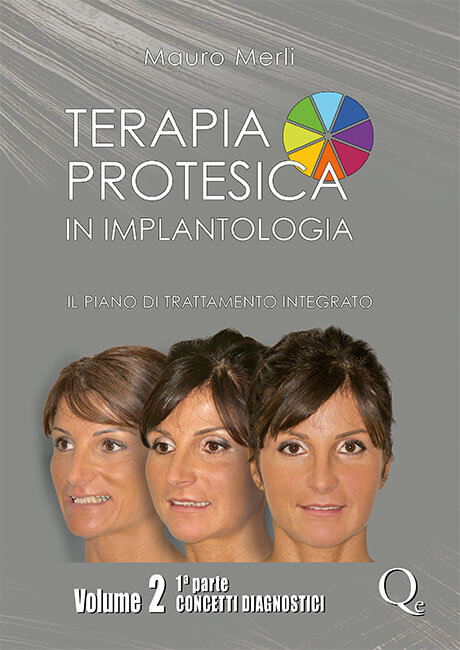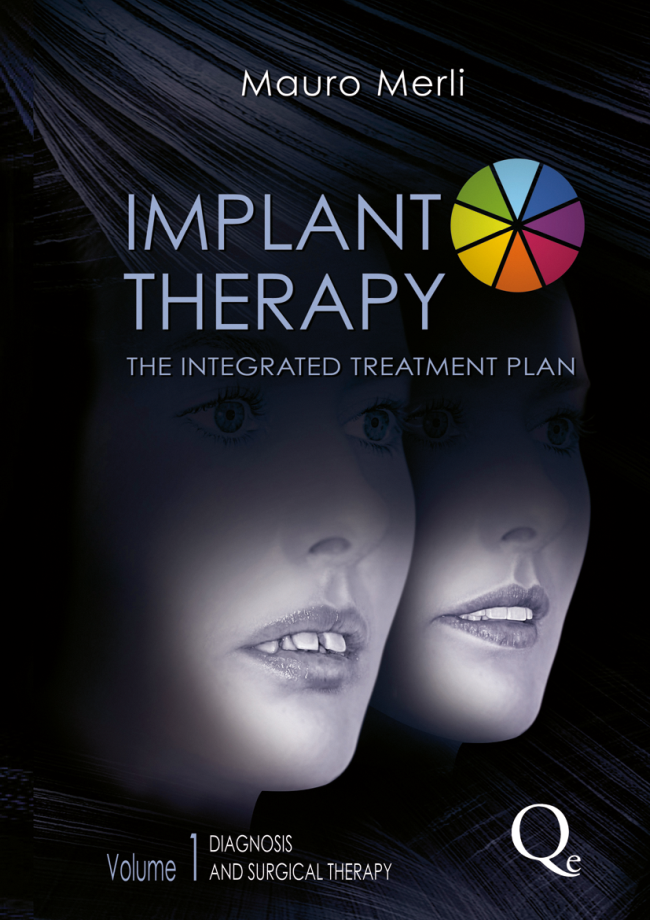The International Journal of Prosthodontics, 2/2025
DOI: 10.11607/ijp.8924, PubMed-ID: 39466615Seiten: 165-174, Sprache: EnglischMerli, Mauro / Aquilanti, Luca / Pagliaro, Umberto / Mariotti, Giorgia / Merli, Marco / Nieri, Michele / Rappelli, GiorgioPurpose: To evaluate the impact of a full digital workflow on the restoration of masticatory function and esthetic features in subjects rehabilitated with a fixed prosthesis. Materials and Methods: The study involved 12 adult participants in need of complex rehabilitation due to masticatory dysfunction. They underwent a comprehensive diagnostic examination involving intraoral scans, facial 3D-photos, jaw kinematics recording, and CBCT extended to the temporomandibular joint (TMJ). The subjects were consecutively treated with a fixed prosthesis following surgical and implant therapy using a full digital individualized workflow. Three different study moments were set: diagnostic phase (T0), 1 week after the delivery of the prototype (T1), and 1 week after the delivery of the final prosthetic solution (T2). Results: Jaw kinematics recording showed a widening of movements at T2 compared to T0. Sagittal movements increased by 5.7 ± 6.4 mm (95% CI from 1.7 to 9.8, P = .010), frontal movements increased by 7.2 ± 5.6 mm (95% CI from 3.6 to 10.8, P = .001), and horizontal movements increased by 1.7 ± 4.5 mm (95% CI from –1.1 to 4.6, P = .210). Occlusal adjustment timing at T1 was 350 ± 175 seconds, while at T2 it was 677 ± 286 seconds. At T2, functional visual analog scale (VAS) was 9.4 ± 0.4 while esthetic VAS was 9.3 ± 0.4. Conclusions: The rehabilitation process using the full digital workflow showed a widening of the sagittal and frontal masticatory movements with short occlusal adjustment time and with functional and esthetic satisfaction by all the subjects.
International Journal of Periodontics & Restorative Dentistry, 1/2024
DOI: 10.11607/prd.6670, PubMed-ID: 37552175Seiten: 103-113, Sprache: EnglischMerli, Mauro / Aquilanti, Luca / Pagliaro, Umberto / Mariotti, Giorgia / Merli, Marco / Nieri, Michele / Rappelli, GiorgioThe present study assessed the impact of a fixed prosthetic rehabilitation on masticatory function in patients diagnosed with stage IV periodontitis. Eligible participants were adults in need of complex rehabilitation due to masticatory dysfunction. Masticatory function was evaluated using the two-colored chewing gum mixing ability test (VOH) at the diagnostic phase (T0), 1 week after delivery of the prosthetic prototype (T1), and 1 week after delivery of the final prosthetic solution (T2). Ten subjects were treated with a fixed prosthesis following periodontal and implant surgery using an individualized, fully digital workflow. Full-mouth plaque and bleeding scores, pocket depth, and clinical attachment level improved significantly. VOH was 0.472 ± 0.168 at T0, 0.358 ± 0.166 at T1, and 0.250 ± 0.123 at T2. A significant improvement in VOH was observed from T0 to T1 (difference: –0.114; 95% CI: –0.199 to –0.029; P = .014) and from T1 to T2 (difference: –0.108; 95% CI: –0.200 to –0.015; P = .027). From T0 to T2, VOH increased by 44.3%. Self-perceived assessment of masticatory function also improved from T0 to T2 (P = .002). The fixed prosthetic rehabilitation in patients with stage IV periodontitis allowed for a significant improvement in objective and subjective measurements of masticatory function.
International Journal of Periodontics & Restorative Dentistry, 4/2022
Online OnlyDOI: 10.11607/prd.6084Seiten: e113-e120, Sprache: EnglischMerli, Mauro / Merli, Marco / Pagliaro, Umberto / Fratini, Adriano / Lo Russo, Lucio / Nieri, MicheleThis study presents a one-stage technique for horizontal guided bone regeneration and transmucosal implant placement in the presence of hard and soft tissue defects. The proposed technique uses autologous bone particles, deproteinized bovine bone matrix, collagen membranes, and concentrated growth factor membranes to create a multilayer barrier and enhance tissue regeneration. Four patients were treated with a total of seven implants. Digital analyses of intraoral scan data taken at baseline and at 6 months postsurgery showed a mean increase in tissue volume of 157.4 mm3. The patient satisfaction was high, and no complications were observed.
International Journal of Periodontics & Restorative Dentistry, 1/2022
DOI: 10.11607/prd.5509Seiten: 65-72, Sprache: EnglischMerli, Mauro / Moscatelli, Marco / Merli, Marco / Mariotti, Giorgia / Pagliaro, Umberto / Nieri, MicheleThe present study clinically and radiographically compares the outcome of implants inserted in maxillary sinuses augmented with concentrated growth factors (CGFs) or demineralized bovine bone matrix (DBBM) in a one-stage lateral approach. In 20 patients with a residual bone height of 1 to 4 mm, lateral sinus floor elevation was performed, using CGFs or DBBM as the sole grafting material, with simultaneous implant placement. Outcome variables were implant and prosthesis failures, complications, subjective satisfaction, and radiographic changes in marginal bone level (MBL) 12 months after surgery. The patients were consecutively recruited: 10 to the CGF group and 10 to the DBBM group. No implant failed in either group at 12 months postsurgery, and there were no complications. There was no statistically significant difference in MBL change between the CGF and DBBM groups (difference of -0.3 mm, favoring the CGF group; 95% confidence interval [CI]: -0.8 to 0.2; P = .18). There was no statistically significant difference in satisfaction (difference of 0.2, favoring the CGF group; 95% CI: -0.2 to 0.6; P = .29). Within the limitations of the present study, the lateral sinus floor elevation performed with the use of CGFs as the sole grafting material showed implant survival rates and marginal bone level changes comparable to DBBM grafting.
International Journal of Oral Implantology, 1/2021
PubMed-ID: 34006075Seiten: 101-112, Sprache: EnglischMerli, Mauro / Moscatelli, Marco / Mariotti, Giorgia / Pagliaro, Umberto / Merli, Marco / Nieri, MichelePurpose: To compare 100% deproteinised bovine bone matrix grafts (DBBM, test group) and 100% autogenous bone grafts (AB, control group) for lateral maxillary sinus floor elevation in a blinded, parallel-group, randomised clinical trial.
Materials and methods: Patients with 1 to 3 mm of residual bone height were randomised for sinus floor elevation with DBBM or AB grafts and simultaneous implant placement. The outcome variables were implant failure, complications, subjective satisfaction and radiographic peri-implant bone level 7 years after loading.
Results: A total of 20 patients (27 implants) were randomised to the test group and 20 (32 implants) to the control group. Ten patients from the test group and seven from the control group dropped out. Two implant failures occurred in the test group, whereas none were observed in the control group (P = 0.178). One complication occurred in the test group and two were recorded in the control group (P = 1.000). The radiographic peri-implant crestal bone level was 2.5 ± 1.3 mm in the test group and 0.9 ± 0.9 mm in the control group. The difference was 1.6 mm, favouring the control group (95% confidence interval 0.7–2.6; P = 0.002). The difference in vertical bone height was −0.4 mm, favouring the control group (95% confidence interval −1.9–1.1; P = 0.590). The difference in satisfaction measured using a visual analogue scale 7 years after loading was 0.0 mm (95% confidence interval −1.0–0.0; P = 0.639).
Conclusions: Differences between treatments were found for crestal bone level, favouring the control group. No differences were observed for the other variables evaluated.
Schlagwörter: bone substitutes, dental implants, maxillary sinus, randomised controlled trial, sinus floor augmentation
Conflict-of-interest statement: The authors declare that this study was self-funded and that none of the authors have any conflict of interest.
International Journal of Periodontics & Restorative Dentistry, 6/2020
DOI: 10.11607/prd.4280, PubMed-ID: 33151186Seiten: 815-823, Sprache: EnglischMerli, Mauro / Mariotti, Giorgia / Mazzoni, Annalisa / Moscatelli, Marco / Pagliaro, Umberto / Nieri, MicheleThis study presents the histomorphometric results of the Wafer Technique, which is based on guided bone regeneration and onlay grafts for 3D bone augmentation. This two-stage technique utilizes autogenous cortical bone plates and collagen membranes, forming a barrier containing a mixture of deproteinized bovine bone matrix, autologous blood, and bone grafted from intraoral sites. Twelve patients were treated. At 6 months postsurgery, histologic analysis of the regenerated areas revealed the presence of compact newly formed bone with no sign of inflammation. The percentages of new bone and native bone (mineralized tissue) were 16.4% (95% CI: 9.5% to 23.2%) and 42.6% (95% CI: 28.2% to 57.0%), respectively. Twenty-five implants were placed. The procedure has been proven to be safe and reliable, and only one transient complication was observed.
International Journal of Periodontics & Restorative Dentistry, 2/2020
DOI: 10.11607/prd.4116, PubMed-ID: 32032400Seiten: 181-190, Sprache: EnglischMerli, Mauro / Mariotti, Giorgia / Pagliaro, Umberto / Mazzoni, Annalisa / Moscatelli, Marco / Nieri, MicheleThe aim of this histologic, single-blind, parallel, randomized clinical trial was to compare vertical bone augmentation grafting with 100% autogenous bone (group AB) vs 50% deproteinized bovine bone matrix (DBBM)/50% autogenous bone (group BOAB) using the Fence Technique in a two-stage implant placement. A biopsy was performed in the regenerated area at implant insertion 6 months after the augmentation surgery. The results reflect a sample size of four patients treated per group. At implant placement, 6 months after grafting, no significant differences were evident in the histomorphometric comparisons, even if the percentage of residual graft was obviously greater in the BOAB group (P = .0314).
Quintessence International, 8/2018
DOI: 10.3290/j.qi.a40764, PubMed-ID: 29989108Seiten: 645-651, Sprache: EnglischVilla, Gabriele / Stavola, Luca De / Fincato, Andrea / Guida, Antonio / Magliano, Antonio / Merli, Mauro / Polizzi, Giovanni / Karl, MatthiasObjective: To evaluate the survival and complication rate of 7-mm short, parallel-walled, conical-connection implants in daily practice.
Method and Materials: This multicenter retrospective study included 219 consecutive patients who received 323 implants. Indication was limited vertical bone height preventing placement of implants longer than 7 mm. Placement and loading protocols were determined on a case-by-case basis and included placement in fresh extraction sockets and healed sites, and loading was either immediate, early, or delayed. Patients were followed for up to 33 months. Outcome measures were implant survival rate and any biologic or technical complications.
Results: In total, eight implants in seven patients failed, accounting for the survival rate of 97.3% at implant level and 96.4% at patient level. The mean time to failure was 7.5 months and 10.2 months at the implant and patient level, respectively. The majority of patients (67.1%) received one implant and the placement was predominantly in healed sites (82.7%). Immediate loading was done for 21.4% of implants placed in the extraction site and for 21.3% of implants placed in healed sites. In most of the cases (71.8%) implants were placed in the premolar or molar position in the mandible. No complications were reported.
Conclusion: These results suggest that in cases of limited vertical bone height, the short, parallel-walled, conical-connection implant can successfully support different prosthesis types in a wide variety of indications and loading protocols.
Schlagwörter: conical connection, multicenter, parallel-walled, retrospective, short implant
International Journal of Oral Implantology, 4/2018
PubMed-ID: 30515484Seiten: 441-452, Sprache: EnglischMerli, Mauro / Moscatelli, Marco / Mariotti, Giorgia / Pagliaro, Umberto / Raffaelli, Eugenia / Nieri, MichelePurpose: The objective of this 3-year post-loading parallel randomised controlled trial is to compare two bone substitutes and resorbable membranes in a one-stage procedure for horizontal bone augmentation: anorganic bovine bone and porcine collagen membranes (BB group) versus synthetic resorbable bone graft substitute made of pure β-tricalcium phosphate and porcine pericardium collagen membranes (CJ group).
Materials and methods: Patients in need of implant treatment having at least one site with horizontal osseous defect at a private clinic in Rimini, Italy, were included in this study. Patients were randomised to receive either BB or CJ in a one-stage procedure for horizontal bone augmentation in a submerged approach. Randomisation was computer-generated with allocation concealment by opaque sequentially numbered sealed envelopes. Patients and the outcome assessor were blinded to group assignment. The abutment connection was made after 6 months of healing. The application of the provisional prosthesis was performed after abutment connection and a definitive metal-ceramic prosthesis was placed 6 months post-loading. The patients were followed-up to 3 years post-loading. Primary outcome measures were: implant failure, complications and peri-implant margin bone level changes. Secondary outcome measures were: visual analogue scale (VAS) for functional and aesthetic satisfaction and pink aesthetic score (PES).
Results: Twenty-five patients with 32 implants were randomly allocated to the BB group and 25 patients with 29 implants to the CJ group. All 50 randomised patients received the treatment as allocated and there were 7 drop-outs in the BB group and 11 drop-outs in the CJ group up to 3 years' post-loading. There were no implant failures. There were six complications in five patients of the BB group and three complications in three patients of the CJ group (relative risk: 1.32, 95% CI from 0.37 to 4.64, P = 1.0000). Radiographic bone loss was 1.61 mm for the BB group and 1.02 mm for the CJ group (difference 0.54 mm, 95% CI from -0.53 to 1.60, P = 0.3100). The functional VAS was 9.0 for the BB group and 9.6 for the CJ group (difference 0.6, 95% CI from -0.4 to 1.5, P = 0.2393). The aesthetic VAS was 9.4 for the BB group and 9.6 for the CJ group (difference 0.2, 95% CI from -0.5 to 0.8, P = 0.6141). PES was 8.7 for the BB group and 8.5 for the CJ group (difference -0.1, 95% CI from -2.9 to 2.7, P = 0.9360).
Conclusions: No significant differences were observed in this randomised controlled trial comparing anorganic bovine bone with porcine collagen membranes versus synthetic resorbable bone made of pure β-tricalcium phosphate with pericardium collagen membranes for horizontal augmentation.
Schlagwörter: bone dehiscence, bone substitutes, dental implant, guided bone regeneration, horizontal bone augmentation, randomised controlled trial
Thommen Medical AG provided the implants as well as the Jason membrane and Ceros TCP free of charge.
International Journal of Oral Implantology, 3/2018
PubMed-ID: 30246181Seiten: 261-280, Sprache: EnglischMerli, Mauro / Moscatelli, Marco / Pagliaro, Umberto / Mariotti, Giorgia / Merli, Ilaria / Nieri, MichelePurpose: To summarise systematic reviews that assess the effects of different interventions for implant prosthetic rehabilitation in partially edentulous patients with the presence of bone atrophy.
Materials and methods: Only systematic reviews of randomised controlled trials (RCTs) dealing with partially edentulous adult patients presenting bone defects were included. Treatments of interest were bone augmentation procedures, use of short, tilted or zygomatic implants, sinus lift and transposition of the inferior alveolar nerve. Outcome variables considered were: prosthetic and implant failure, complications, radiological and clinical peri-implant bone level variation, aesthetic and functional satisfaction, and vestibular peri-implant soft tissue recession. A search of systematic reviews of RCTs selected from MEDLINE, the Cochrane Database of Systematic Review, and the Prospero register published in the past 5 years (May 2012 - May 2017) was performed. Systematic reviews were also manually searched. Independent data extraction by two authors using predefined data fields, including ROBIS risk of bias, was executed.
Results: A total of 12 systematic reviews of RCTs were identified for inclusion in the overview. Eight reviews were considered at low risk of bias. Short implants (≤ 8 mm) were associated with a notable decrease in complications compared to long implants with bone augmentation procedures. Many trials compared different sinus lift procedures and different bone augmentation techniques. None of these indicated that one procedure could reduce prosthetic or implant failures when compared to the other. The use of a membrane can contribute to the regeneration of the hard tissue in horizontal augmentation. Different membranes or bone substitutes did not give substantially different results. No data are available regarding comparisons involving zygomatic implants or tilted implants or transposition of the alveolar nerve.
Conclusions: Overall, the evidence is not sufficiently robust to determine the best treatment for implant prosthetic rehabilitation in partially edentulous patients presenting bone atrophy. In terms of vertical defects, if the short implants can be used they should be used because the number of complications are reduced compared to longer implants with sinus lift or bone augmentation. Nevertheless, caution should be exercised because long-term follow-up studies were not available. No conclusions can be drawn regarding the comparison between different vertical bone augmentation techniques in atrophic posterior mandible because quantitative meta-analyses were not performed. With regards to horizontal defects, the use of a membrane appears to increase the regeneration of the hard tissue but no differences were detected in prosthesis or implant failures or in complications.
Schlagwörter: bone regeneration, dental implants, overview of systematic review, umbrella review






